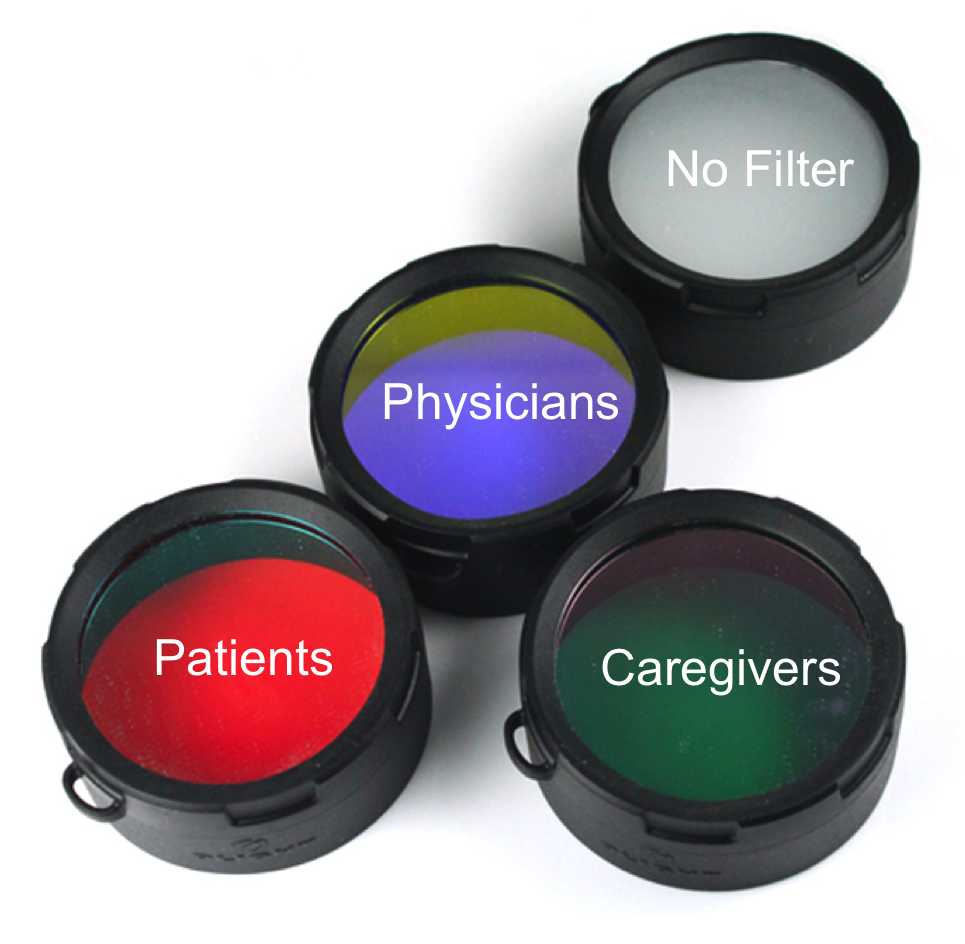Let me share with you a few insights so far on Stanford Medicine X 2015 (MedX), but first, let’s talk about colored filters, how our individual filters blind our perspective, and why we must remove our individual filters in order to make the most of Medicine X.
 As you know, when the white light from a flashlight is shined onto a canvas, the canvas is illuminated. If, however, a blue-colored filter is placed in the light’s beam, the only color seen on the canvas will be blue, and the same goes for red, yellow, or other colors within the visual spectrum. Said differently, the colored filter removes from view all colors except that of the filter itself.
As you know, when the white light from a flashlight is shined onto a canvas, the canvas is illuminated. If, however, a blue-colored filter is placed in the light’s beam, the only color seen on the canvas will be blue, and the same goes for red, yellow, or other colors within the visual spectrum. Said differently, the colored filter removes from view all colors except that of the filter itself.
This week at MedX I have been inspired, engaged, and enthused for the future of healthcare. I have listened to amazing presentations by physicians, medical students, nurses, pharmacists, social workers, patients, caregivers, innovators, and thought leaders. MedX, organized by the talented Dr. Larry Chu delivers as promised, strategically placing MedX at the “intersection between medicine and emerging technologies.” I have enjoyed the presentations, the panels, the small-group discussions, and have attempted to contribute relevant content and insights to the live #MedX Twitter feed. In a few days, MedX will be but a fond-memory for the masses, but its legacy will be in its ability to catalyze change.
In a few days, #MedX will be but a fond-memory for the masses, but its legacy will be its ability to catalyze change https://eyesteve.com/medx/ Click To TweetMy fear, however, is that our personal filters, speckled with bias, background, and experiential anecdotes, if not carefully scrutinized, may limit our vision. These filters, if not removed, may cause us to screen out the insights of all the other colors, leaving us only to view MedX through our own polarized filter, and blind to views different from our own.
The filters through which which we view #MedX, if not removed, may leave us blind to views different from our own Click To Tweet MedX has benefitted from representation by many groups, including:
MedX has benefitted from representation by many groups, including:
- The providers – physicians, pharmacists, nurses
- The educators – academicians, interdisciplinary learning experts
- The patients – cancer survivors, chronic disease sufferers, patient advocates
- The caregivers – parents, children, friends
- The innovators – tech entrepreneurs, 3D printers, virtual realists
- The thought leaders – book authors, renowned experts
Each group, often seated together, watches as the MedX spotlight shines on the stage’s canvas, with group members internalizing, annotating, and tweeting their insights. These insights, however, seem to occasionally be limited by participants watching MedX through only the filtered biases of their background. The patient advocates argue for increased democratization of health records, the providers shudder at impending realities of external hard drives of scanned PDFs brought by e-patients to clinic visits; the educators hear these discussions and wonder only how they can possibly teach tomorrow’s doctors to give more face-time to the patients and away from the computer, the entrepreneurs consider only how to create apps to aggregate big data to make big dolla, and the thinkers pontificate in an attempt to put it all together with insight and profundity.
This phenomenon is natural, you argue. ‘We are a product of our experiences and these experiences mold our perceptions.’ Yes–indeed very true. I have not yet experienced the difficulties of chronic illness, nor sat among academicians responsible to develop a curriculum for tomorrow’s learners, nor entrepreneured a multi-million dollar startup supported by parental angelic investors. We enter the halls of Medicine X with our own unique backgrounds, though these same backgrounds may skew our views and alter our analysis. The MedX diversity is what makes it MedX, bringing together all who believe we can collectively use technology and innovation to improve healthcare for all.
We enter #MedX with unique backgrounds, though these same backgrounds may skew our views and alter our analysis Click To TweetOur individual and group backgrounds, however, have the potential to be just like the colored filter, causing us to view MedX only through our colored filter, remaining blind to the other viewpoints of those around us. If not careful to remove the filter from my view, I may disregard the patient advocates’ plea for increased engagement and autonomy, fail to empathize with the academician struggles to design tomorrow’s curriculum, not fully appreciate the contributions of nurses, pharmacists, and social workers, or remain critical of my smartphone-staring-students without realizing these medical students are simply using digital apps like Picmonics or Figure 1 in a learning strategy different from my own. To view MedX through only my filter is a disservice not only to the other colors in the rainbow, but also to myself, for it is by viewing the entire visible color spectrum that I can better contribute insightful solutions to the challenges facing healthcare today.
The solution is simple, the challenge is difficult, but the result will be priceless. When watching a presentation or following the #MedX Twitter feed, we must do all we can to remove our filtered lenses, as it is only by understanding and appreciating all the colors of MedX may we create lasting change for the better.
While at #MedX, I pledge to remove my personal filters and embrace all colors! Click To Tweet







